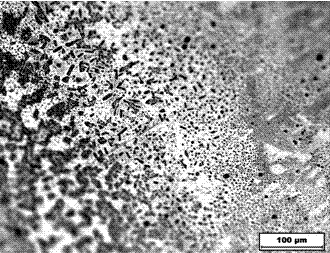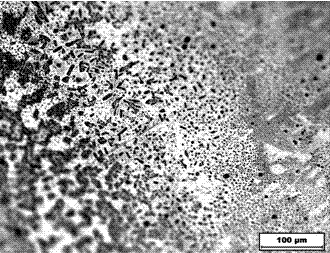Method for preparing iron-based surface composite material by virtue of in-situ synthesis
A surface composite material and in-situ synthesis technology, which is applied in the field of in-situ synthesis of iron-based surface composite materials, can solve problems such as splitting, low density of composite materials, and difficult control of the reaction process, and achieve easy process implementation and adaptability Strong, effective combined effect
- Summary
- Abstract
- Description
- Claims
- Application Information
AI Technical Summary
Problems solved by technology
Method used
Image
Examples
Embodiment 1
[0020] Al, Fe 2 o 3 The powder is uniformly mixed with a mass fraction of 3:2. Under the pressure of 20MPa, the mixed powder raw material is pressed into a powder blank with a diameter of 3 mm and a length of 5 mm under a pressure of 20 MPa; Preheat at 120°C for 30 minutes, and heat the powder blank at 600°C for 30 minutes; then crush the pre-sintered powder blank, and obtain 0.3mm powder mixture particles by sieving; use 2wt.% water glass as the binder, and the particles The pre-sintered materials of the reactants are bonded together and dried to form a preform with a strength of 40MPa, and then the mold is closed, and high-chromium cast iron is poured continuously at 1400°C to form an iron-based composite material.
[0021] figure 1 for -Al 2 o 3 The microstructure of particle-reinforced high-chromium cast iron composite material. It can be seen from the figure that the reinforcement particles in the composite material are relatively uniform in distribution, with a siz...
Embodiment 2
[0023] Al, Fe 2 o 3 Mix the powder evenly with a mass fraction of 5:2, and press the mixed powder raw material into a powder blank with a diameter of 15mm and a length of 15mm under a pressure of 120MPa using a high-strength mold; Preheat for 40 minutes at ℃, and heat the powder blank at 700℃ for 20 minutes; then crush the pre-sintered powder blank, and obtain 3.0mm powder mixture particles by sieving; a frame with a height of 20mm and an upper end opening made of steel wire mesh, the mesh The hole size is 2mm, the powder mixture particles are randomly put into the steel mesh frame, and the steel mesh frame is fixed on the upper surface of the cavity by hanging method, then the mold is closed, and high chromium cast iron is poured continuously at 1420°C to form Iron-based composites.
[0024] The wear test shows that when the compressive stress is 100MPa and the sliding wear rate is 50m / s, the wear loss of the new iron-based composite material is 40% of that of high-chromium...
Embodiment 3
[0026] Al, Fe 2 o 3 Mix the powder uniformly with a mass fraction of 2:1. Under the pressure of 80MPa, use a high-strength mold to press the mixed powder raw material into a powder blank with a diameter of 8mm and a length of 10mm; Preheat for 35 minutes at ℃, and heat the powder blank at 650℃ for 25 minutes; then crush the pre-sintered powder blank, and obtain 1.2mm powder mixture particles by sieving; The pre-sintered materials of the reactants are bonded together and dried to form a preform with a strength of 50MPa, and then the mold is closed, and high-chromium cast iron is poured continuously at 1380°C to form an iron-based composite material.
[0027] The wear test shows that when the compressive stress is 50MPa and the sliding wear rate is 100m / s, the wear loss of the new iron-based composite material is 30% of that of high-chromium cast iron when the grinding wheel is used as the counter-abrasive material for 30 minutes.
PUM
| Property | Measurement | Unit |
|---|---|---|
| size | aaaaa | aaaaa |
| thickness | aaaaa | aaaaa |
| strength | aaaaa | aaaaa |
Abstract
Description
Claims
Application Information
 Login to View More
Login to View More - R&D
- Intellectual Property
- Life Sciences
- Materials
- Tech Scout
- Unparalleled Data Quality
- Higher Quality Content
- 60% Fewer Hallucinations
Browse by: Latest US Patents, China's latest patents, Technical Efficacy Thesaurus, Application Domain, Technology Topic, Popular Technical Reports.
© 2025 PatSnap. All rights reserved.Legal|Privacy policy|Modern Slavery Act Transparency Statement|Sitemap|About US| Contact US: help@patsnap.com


